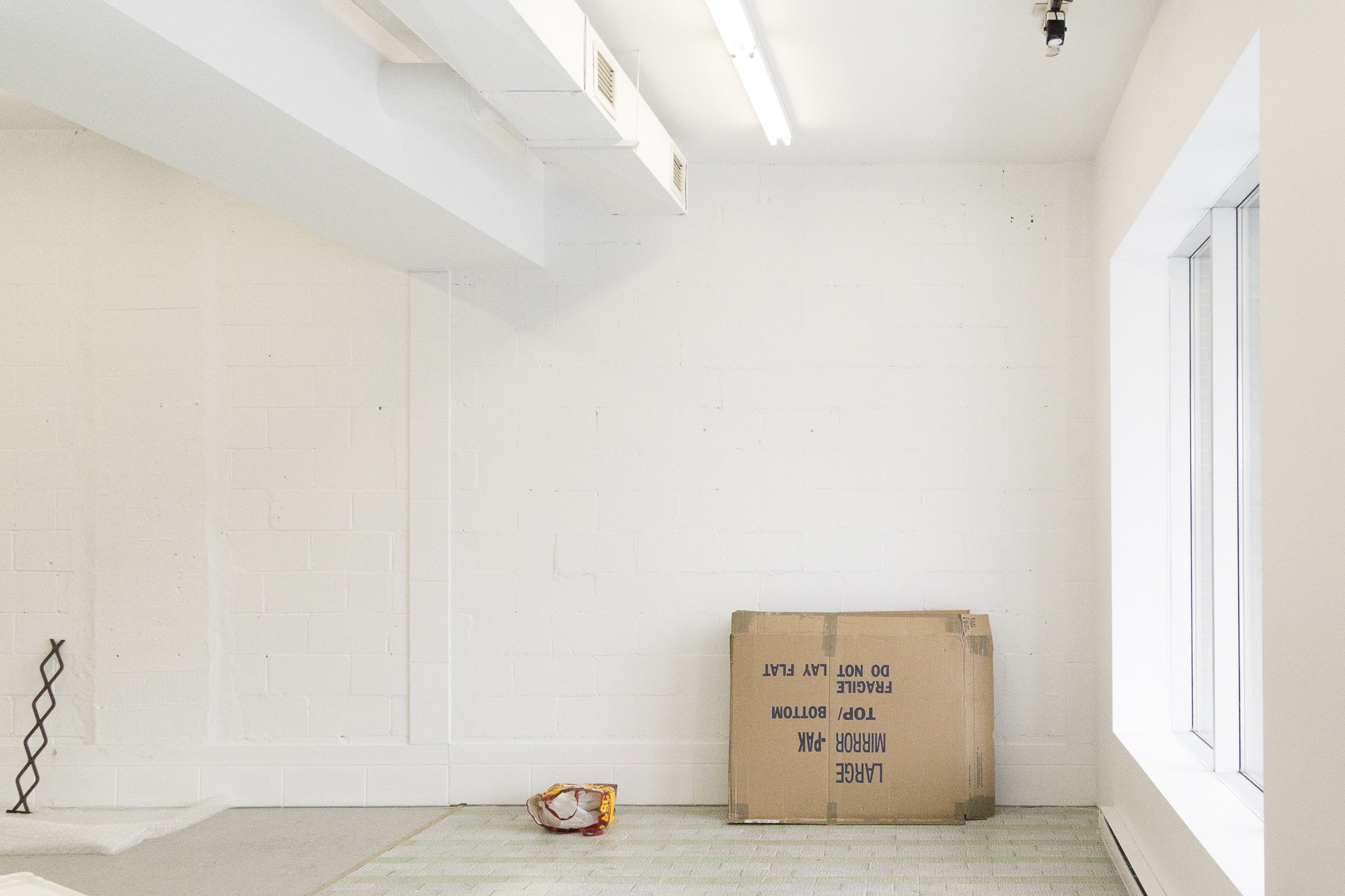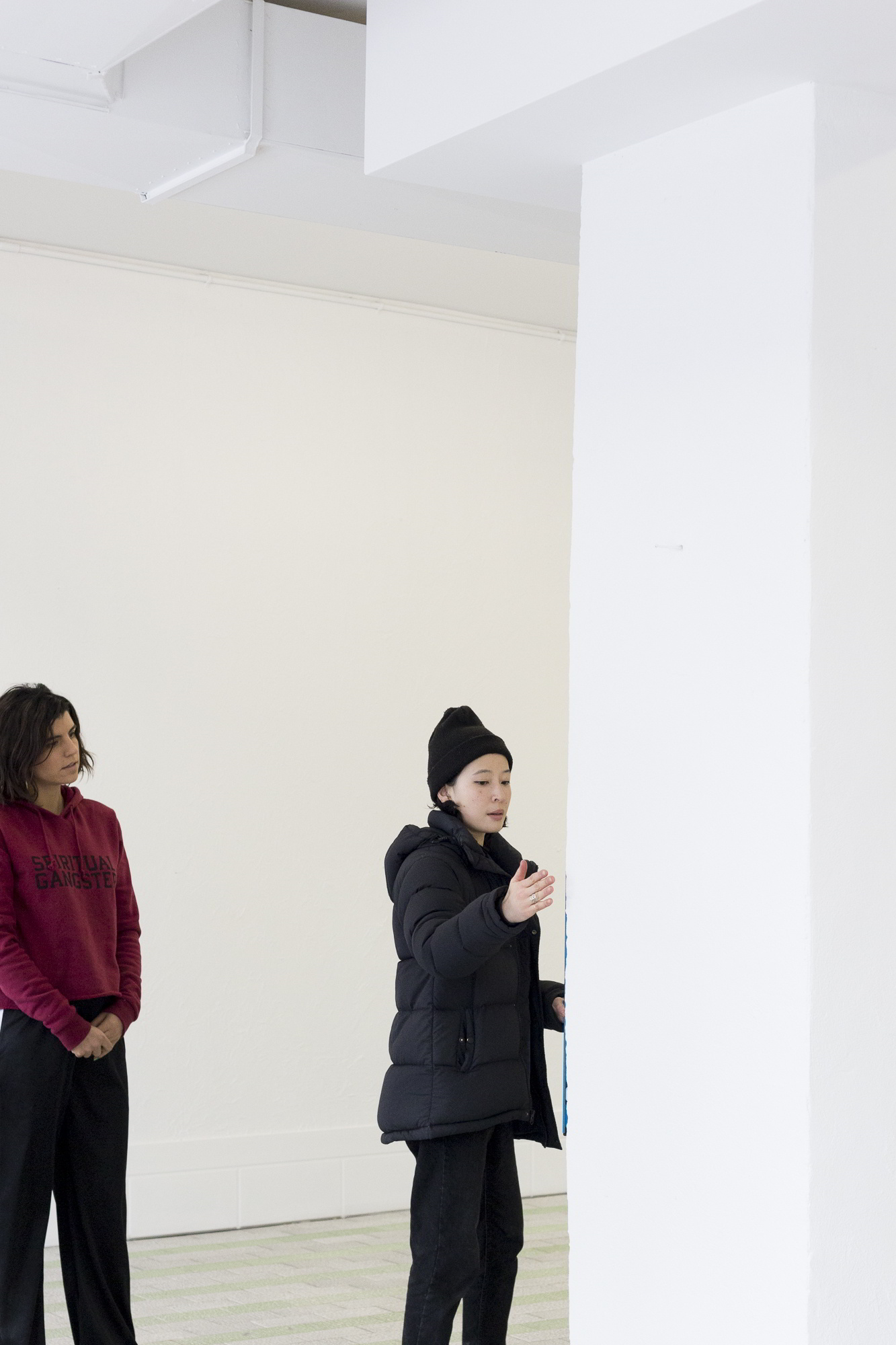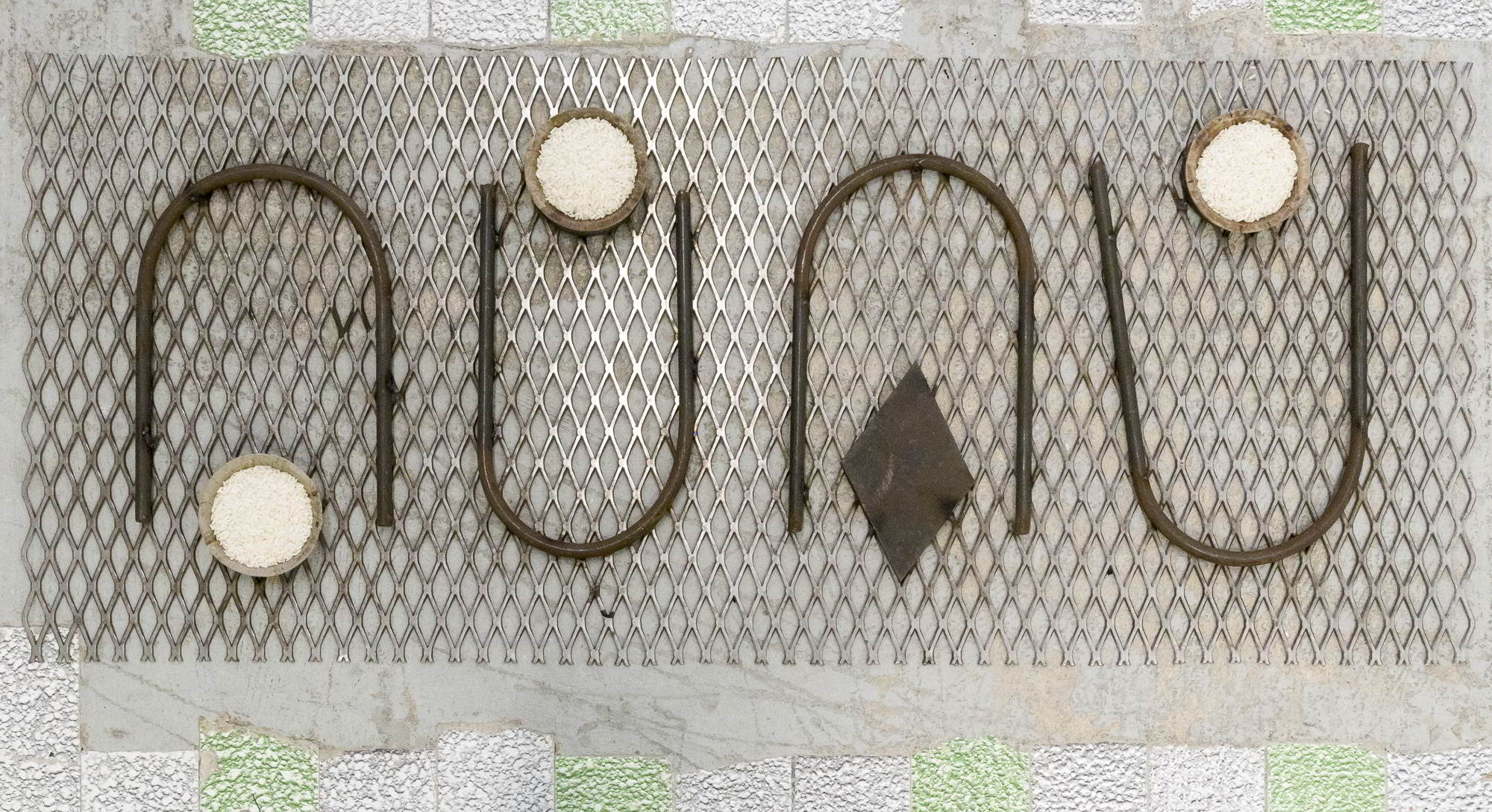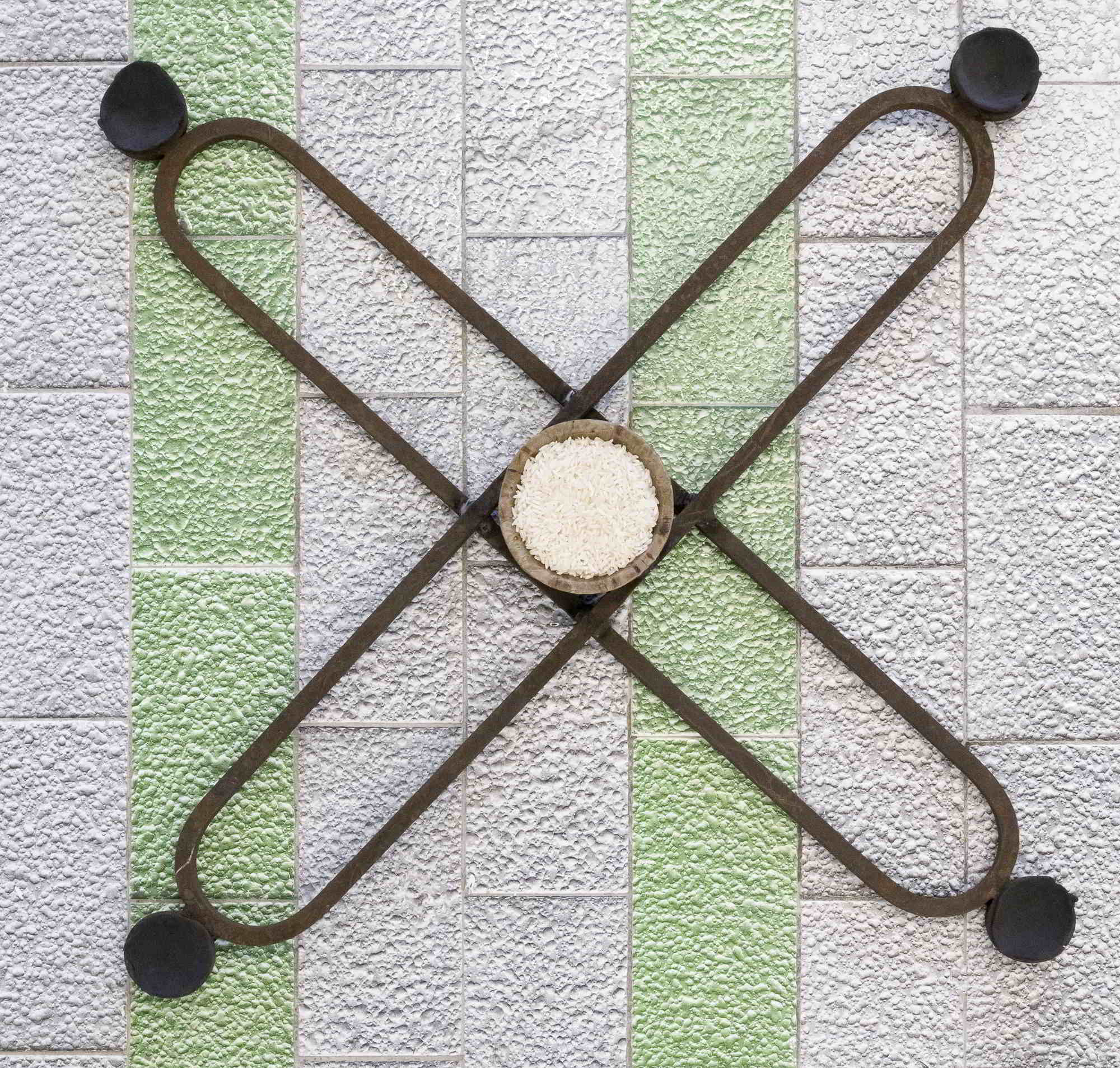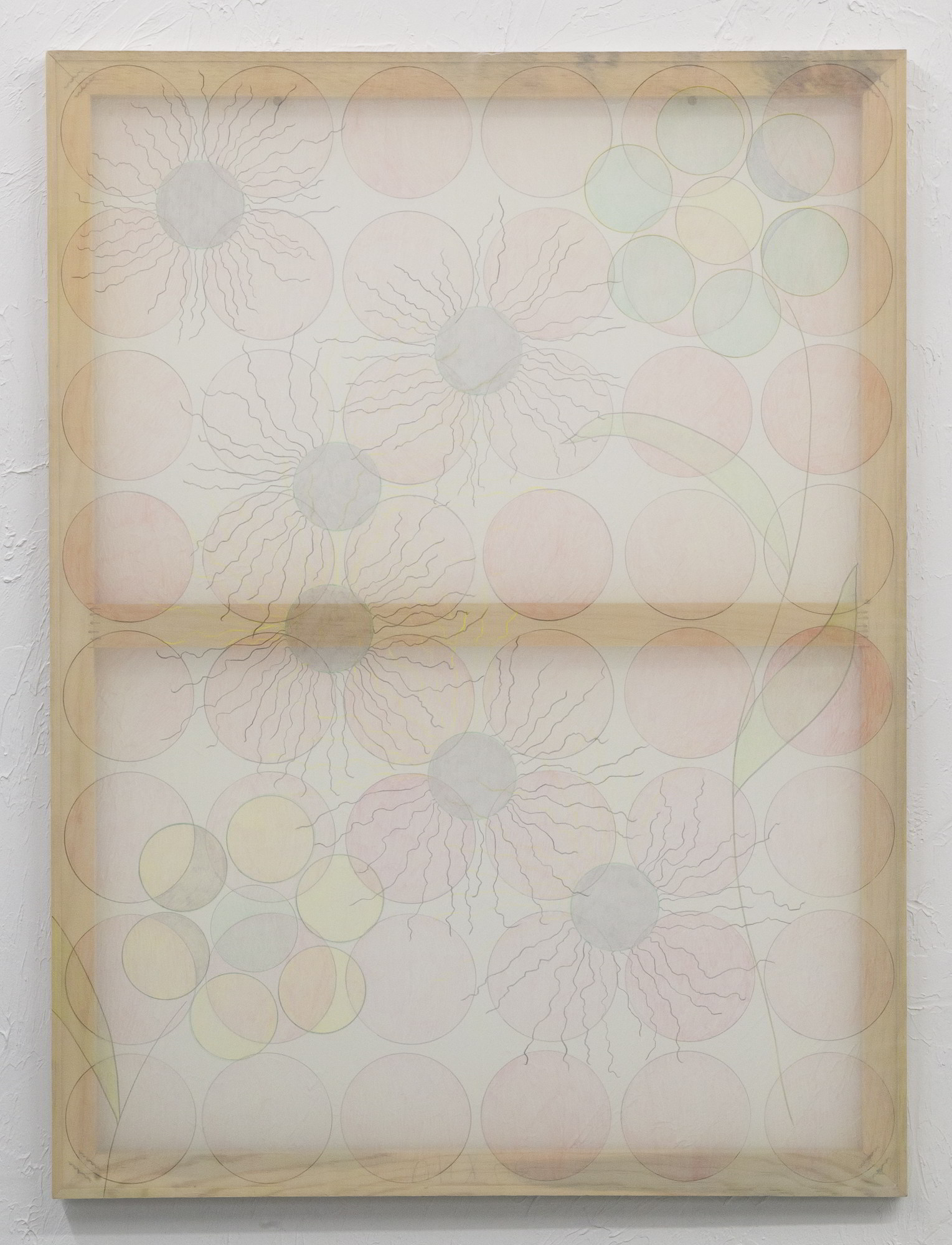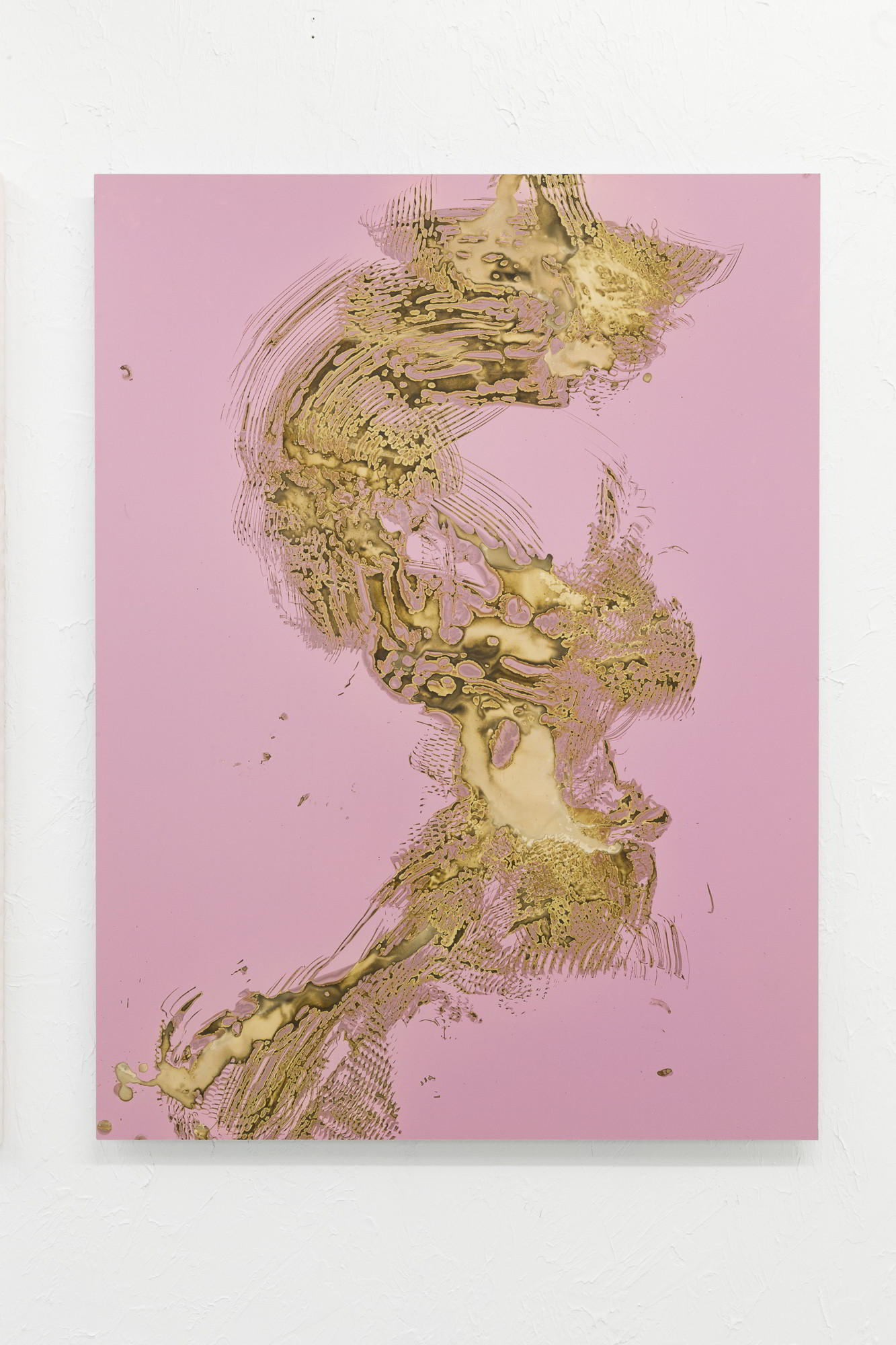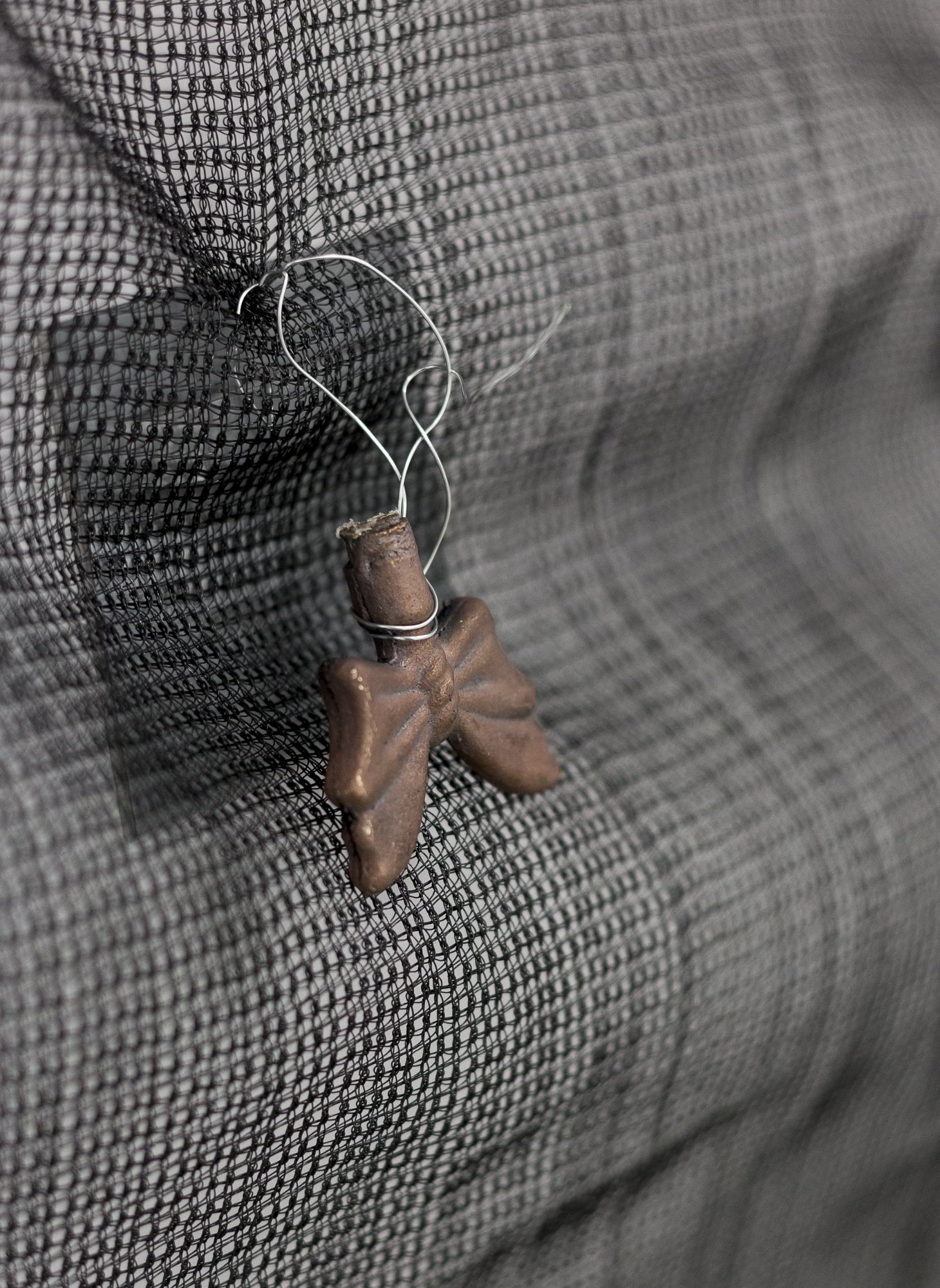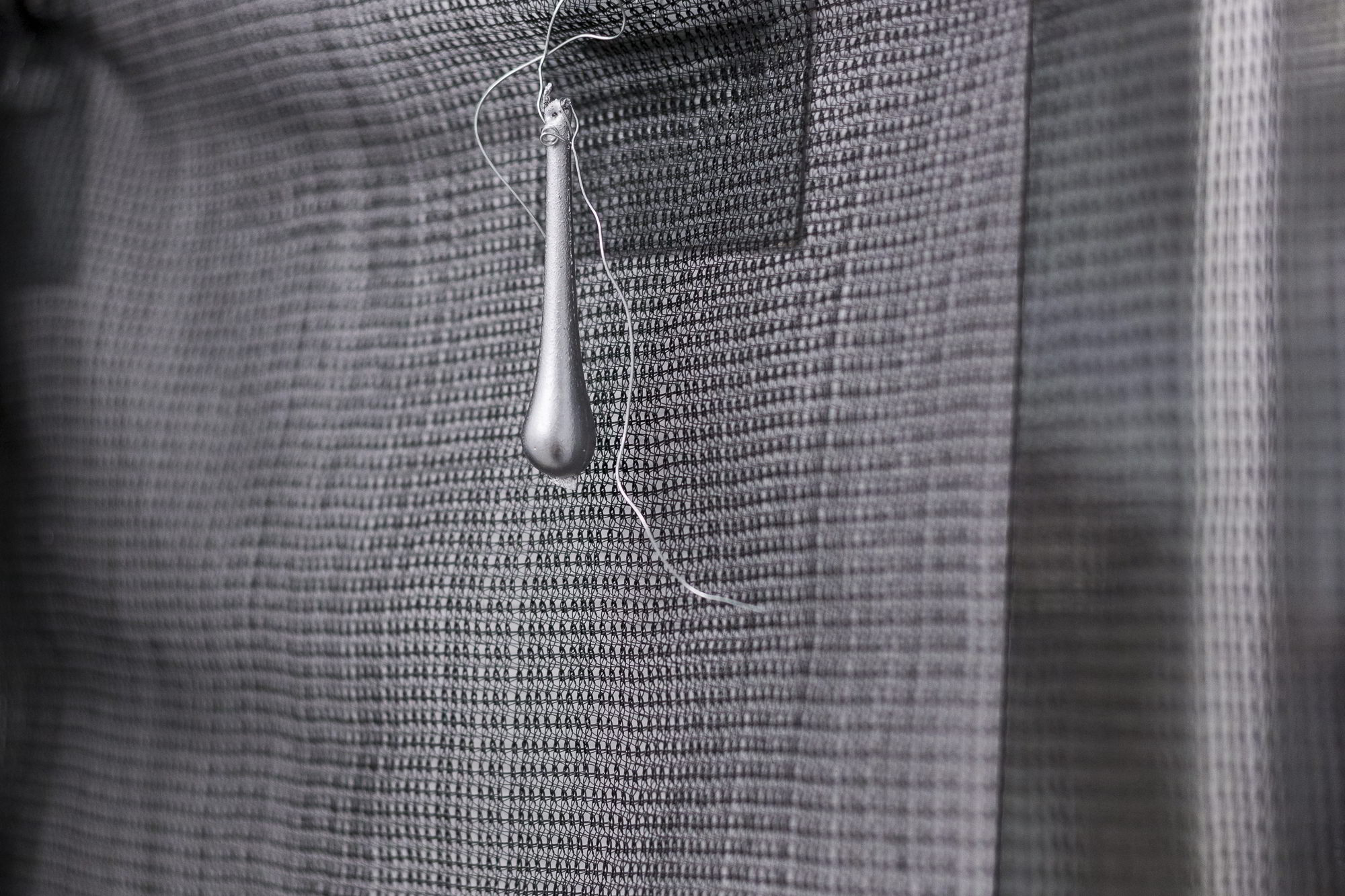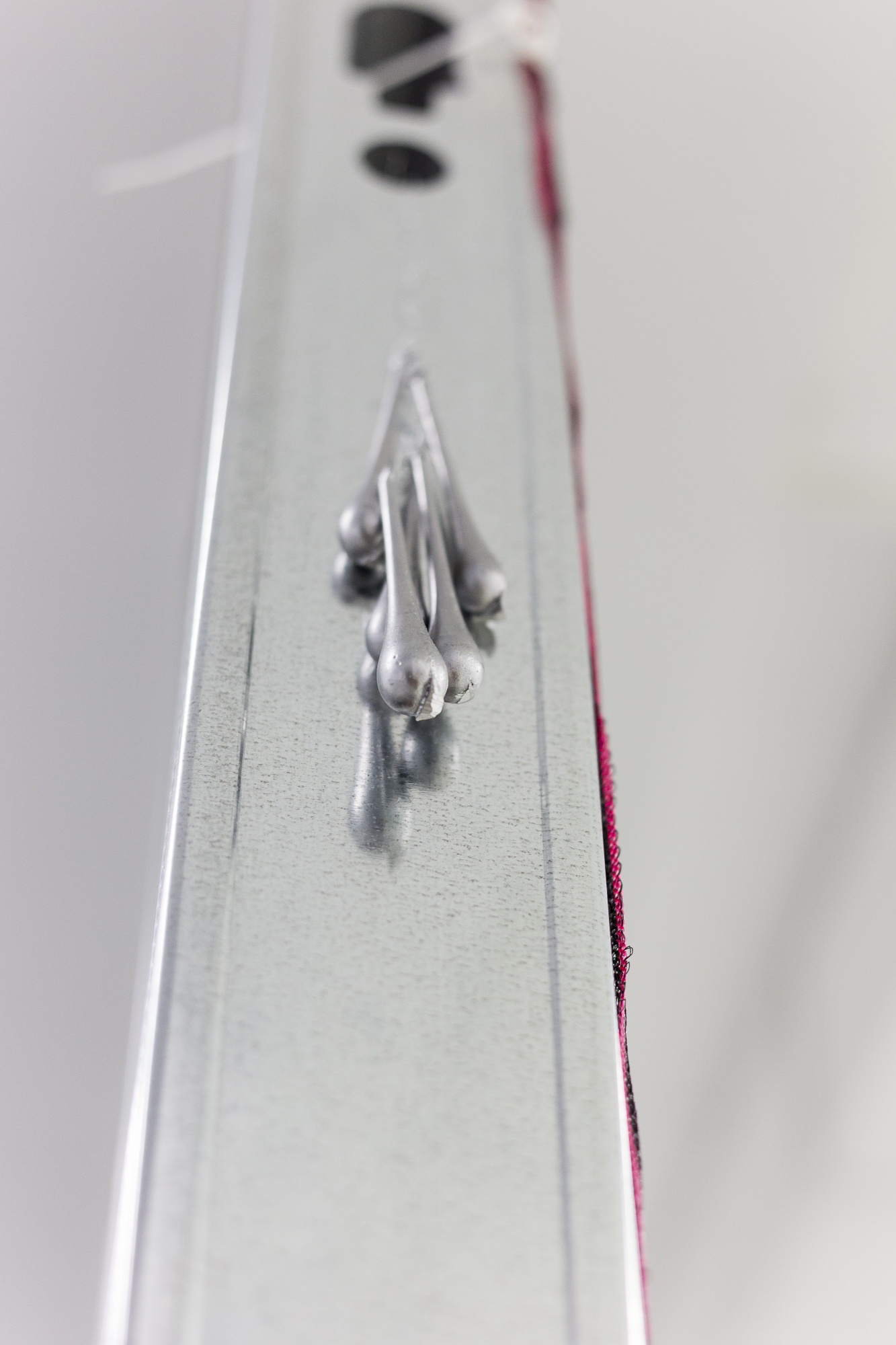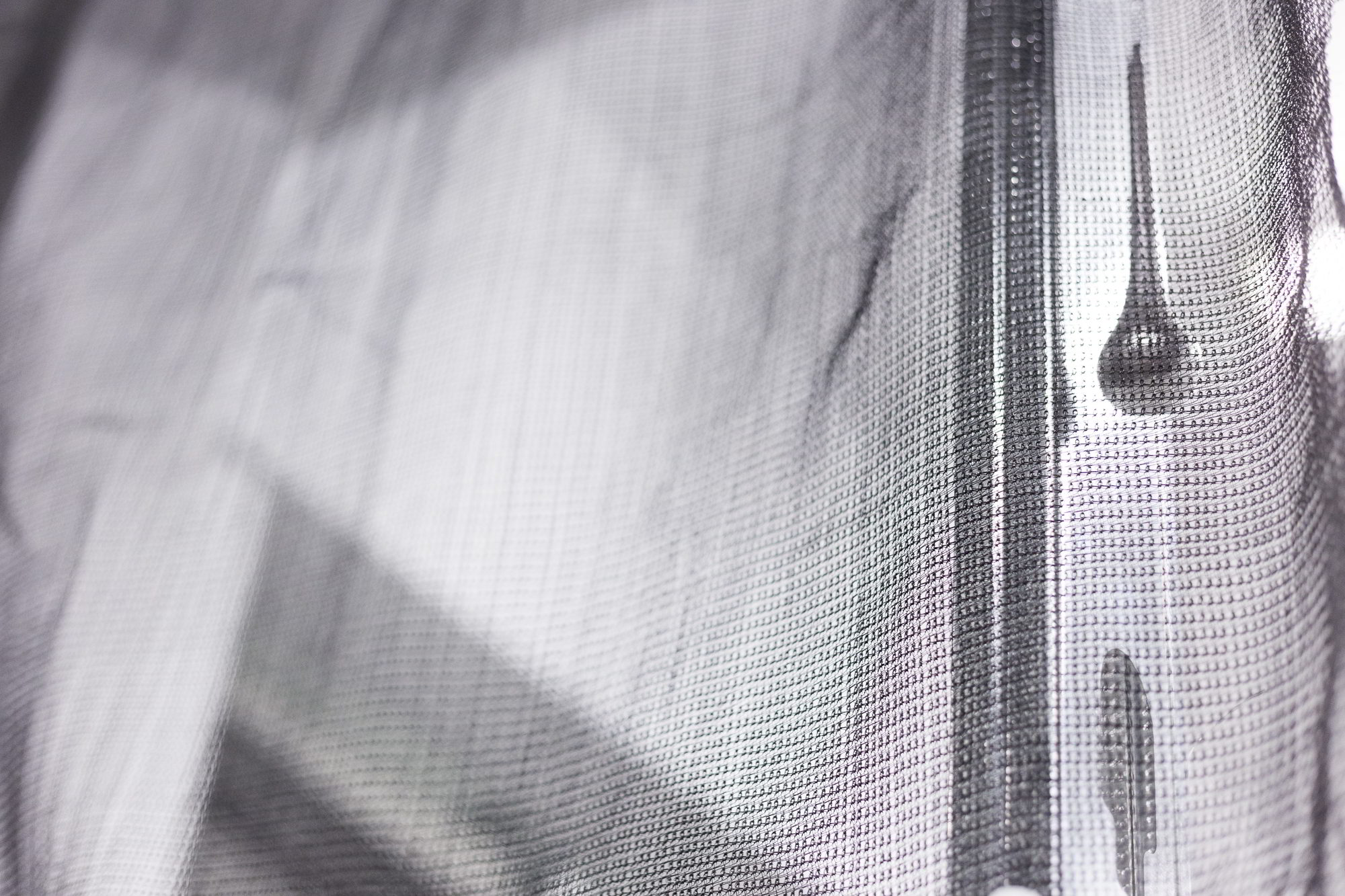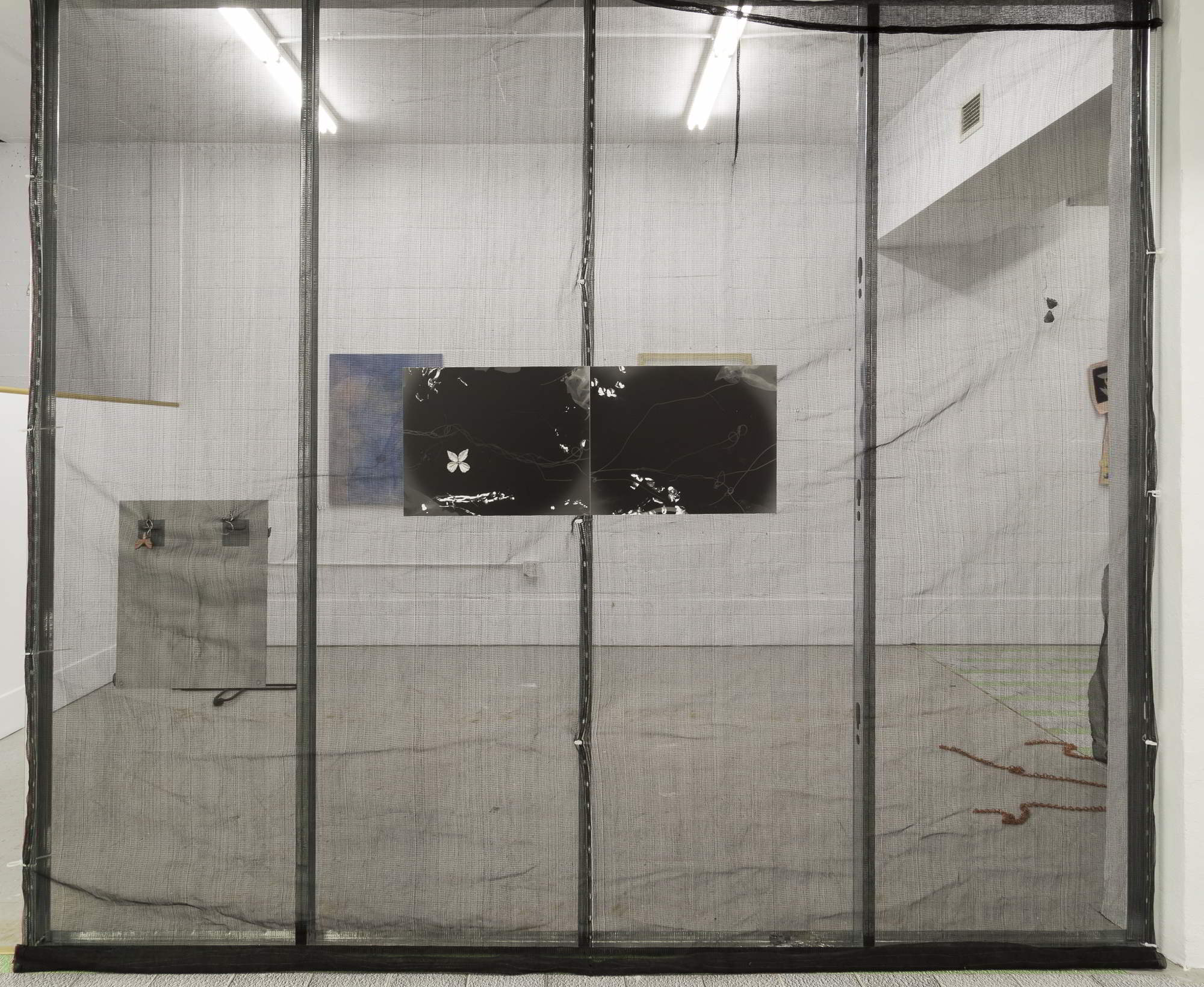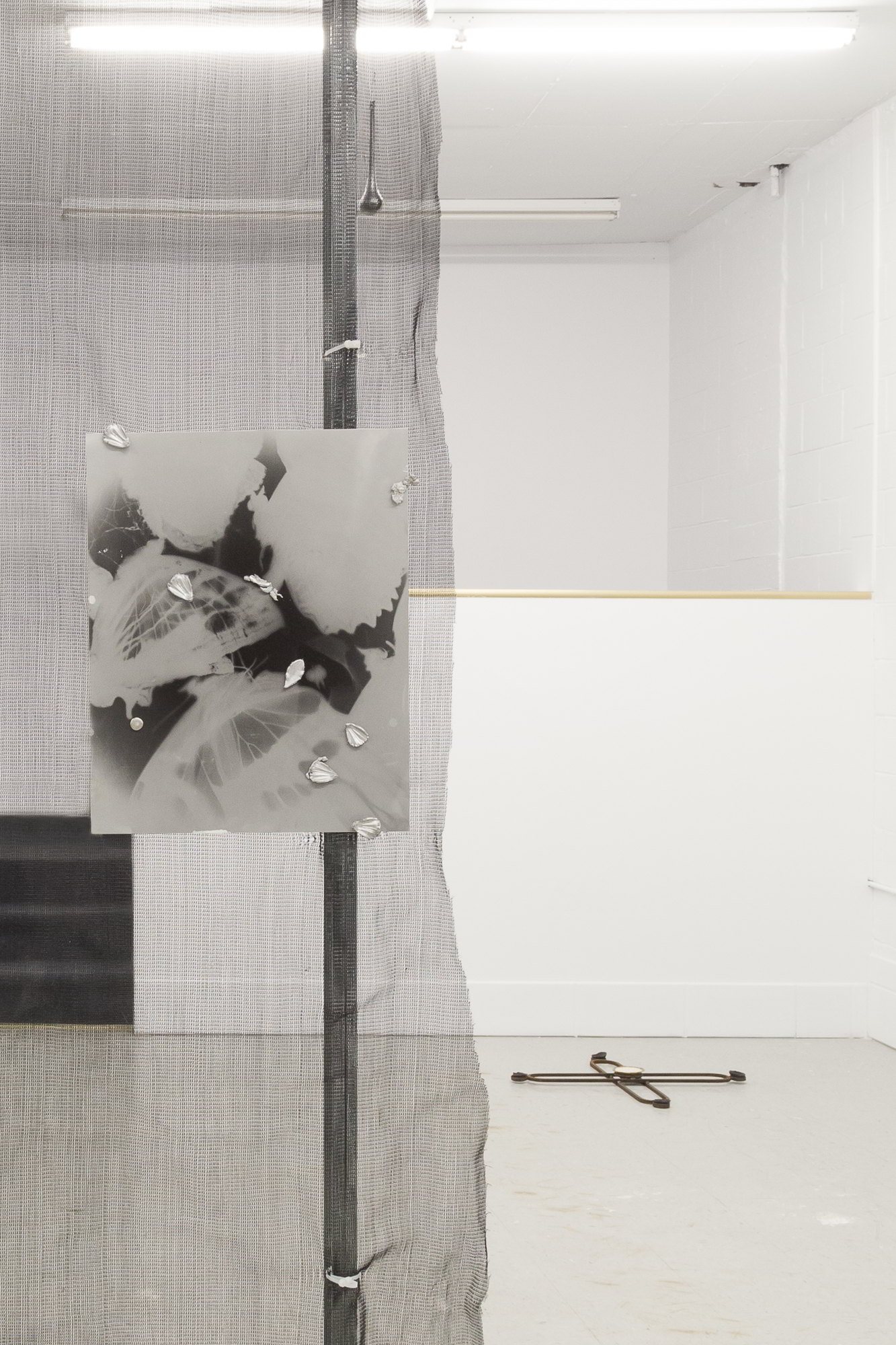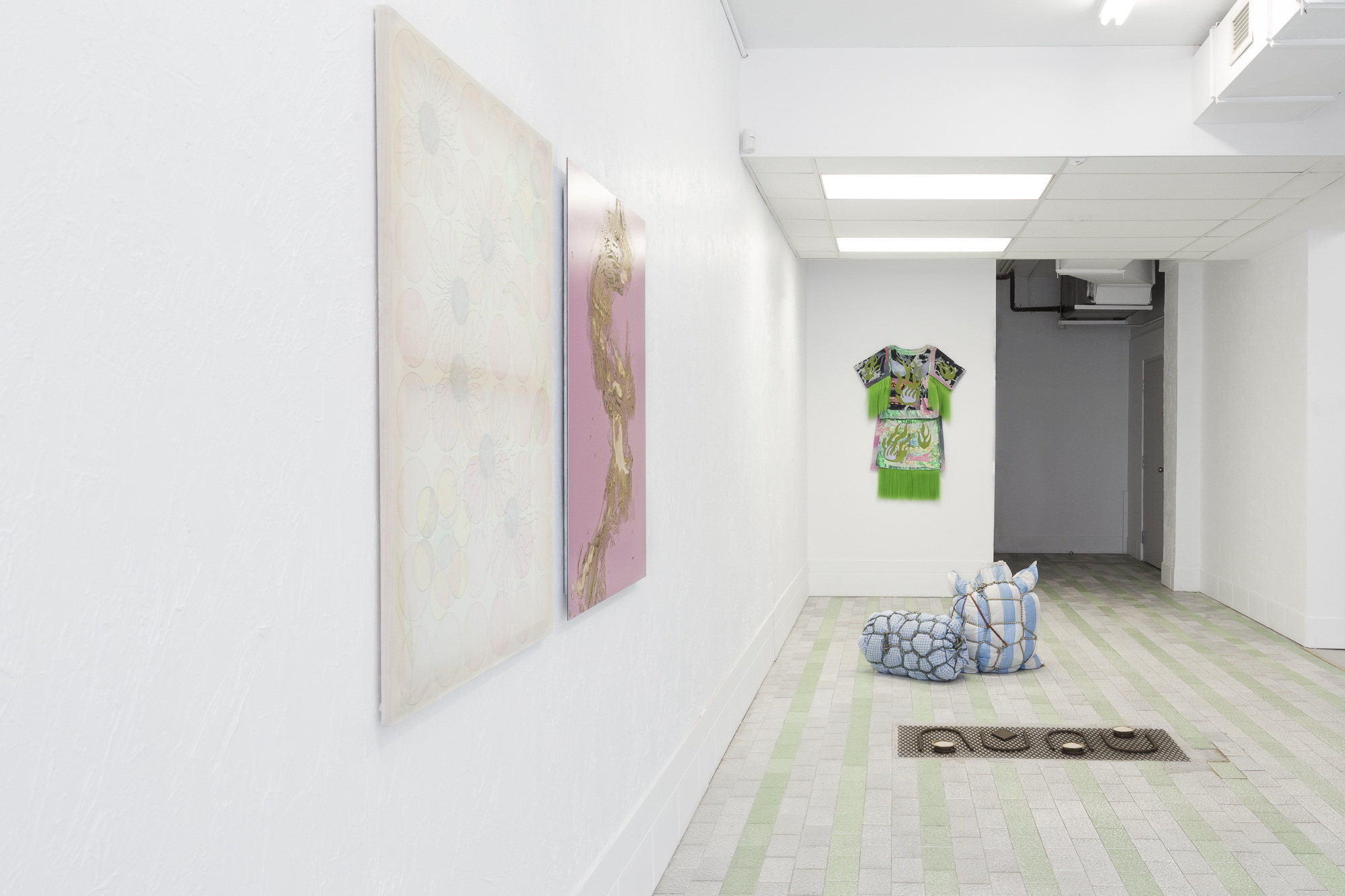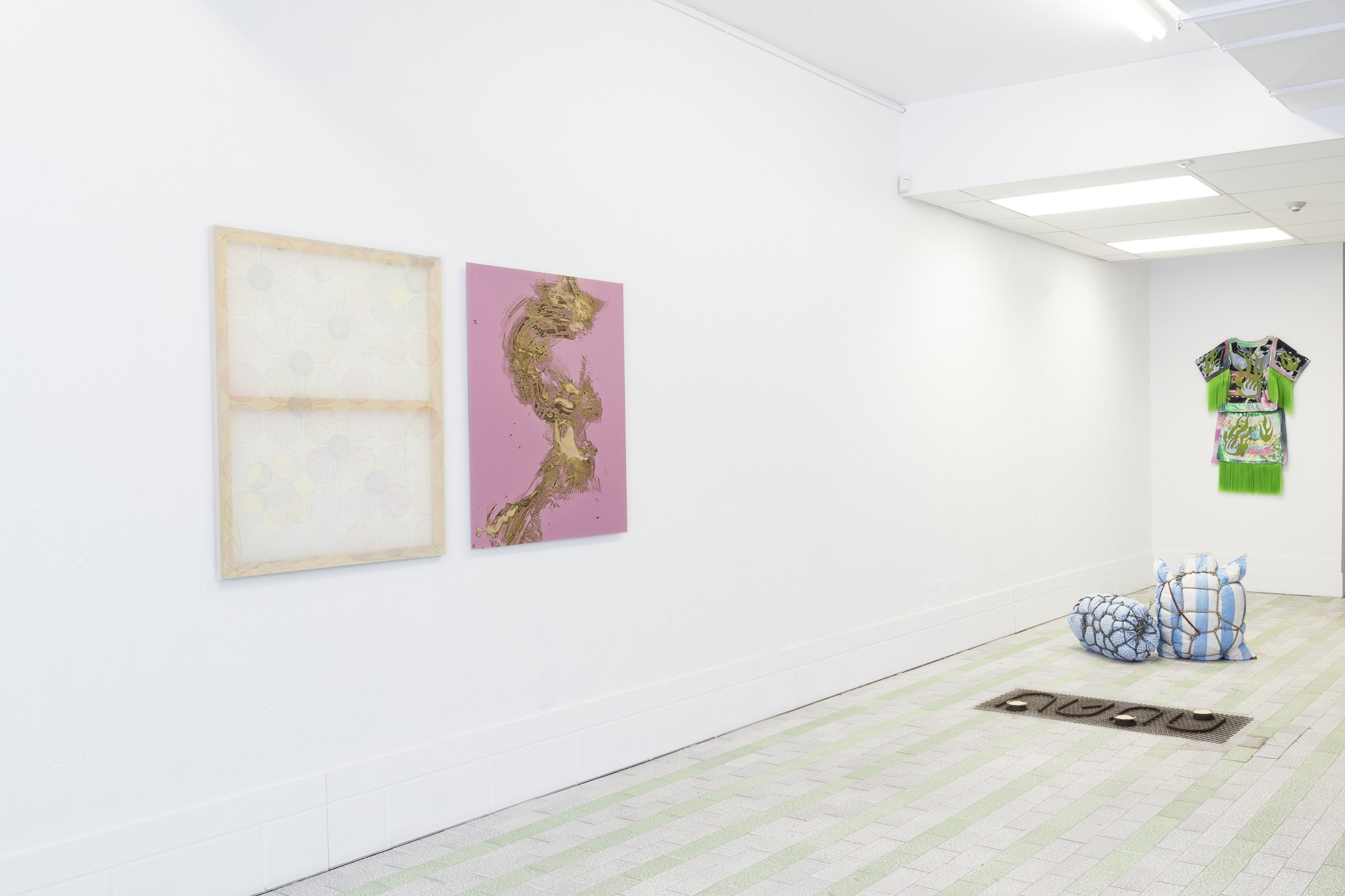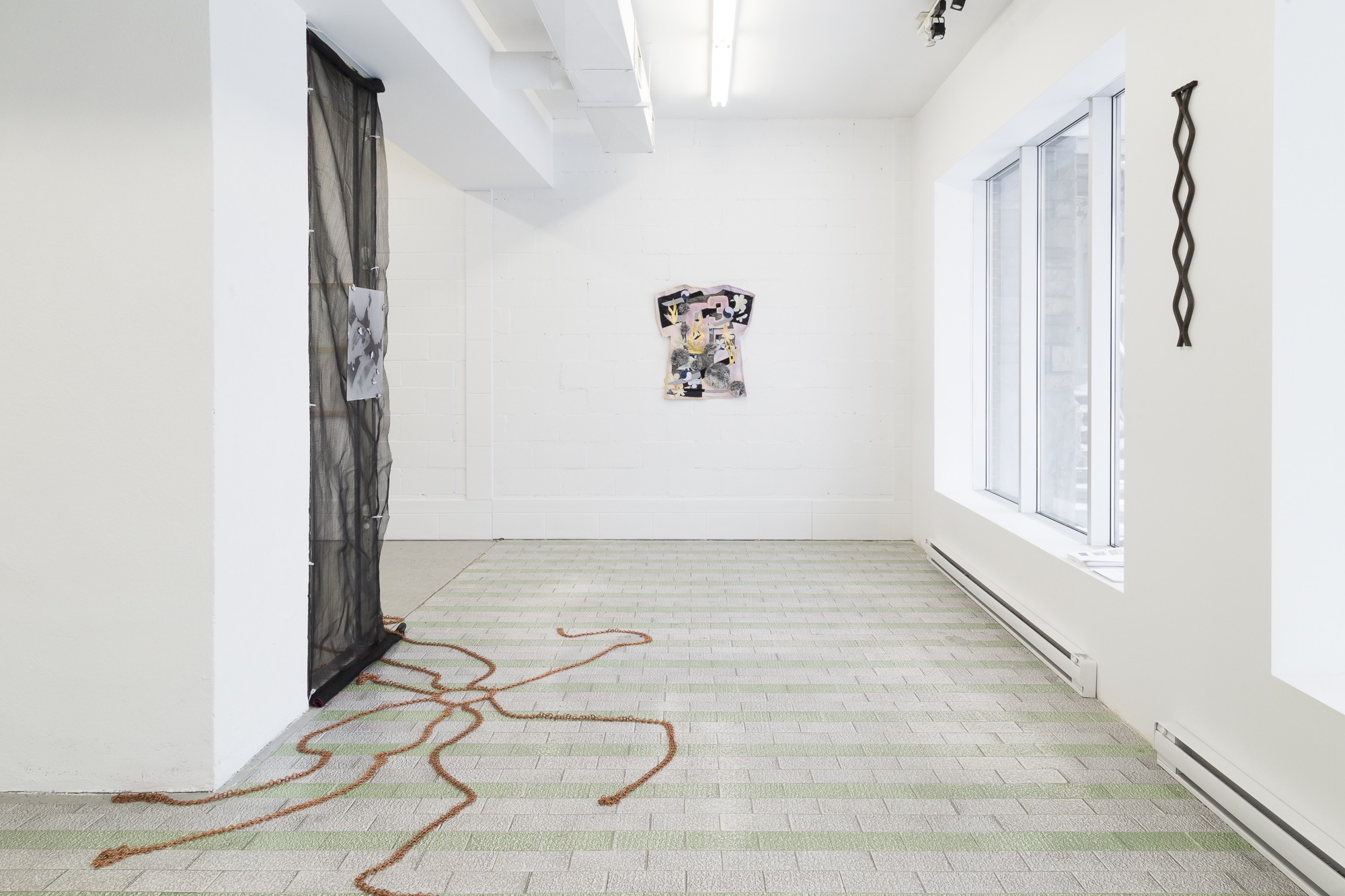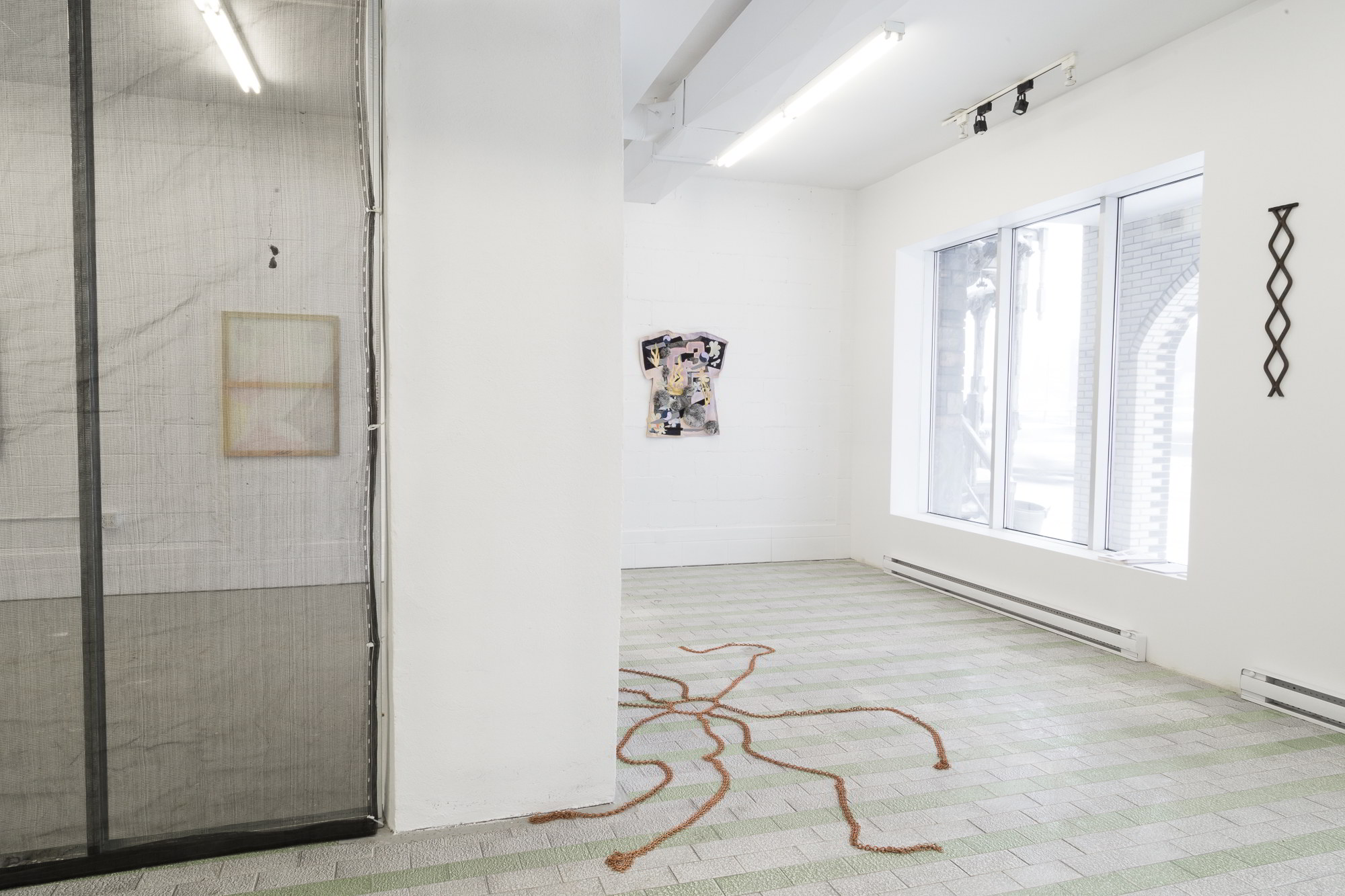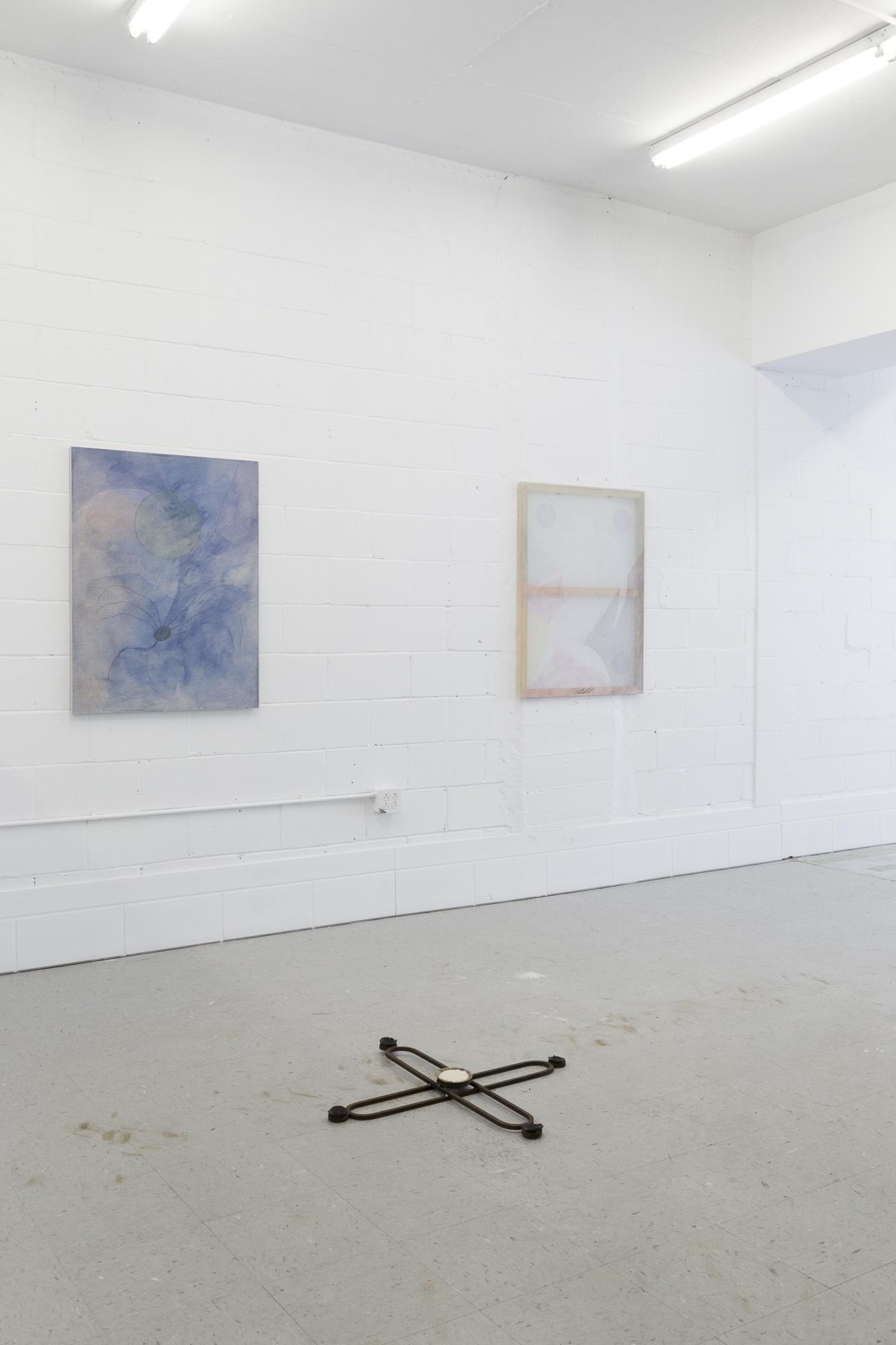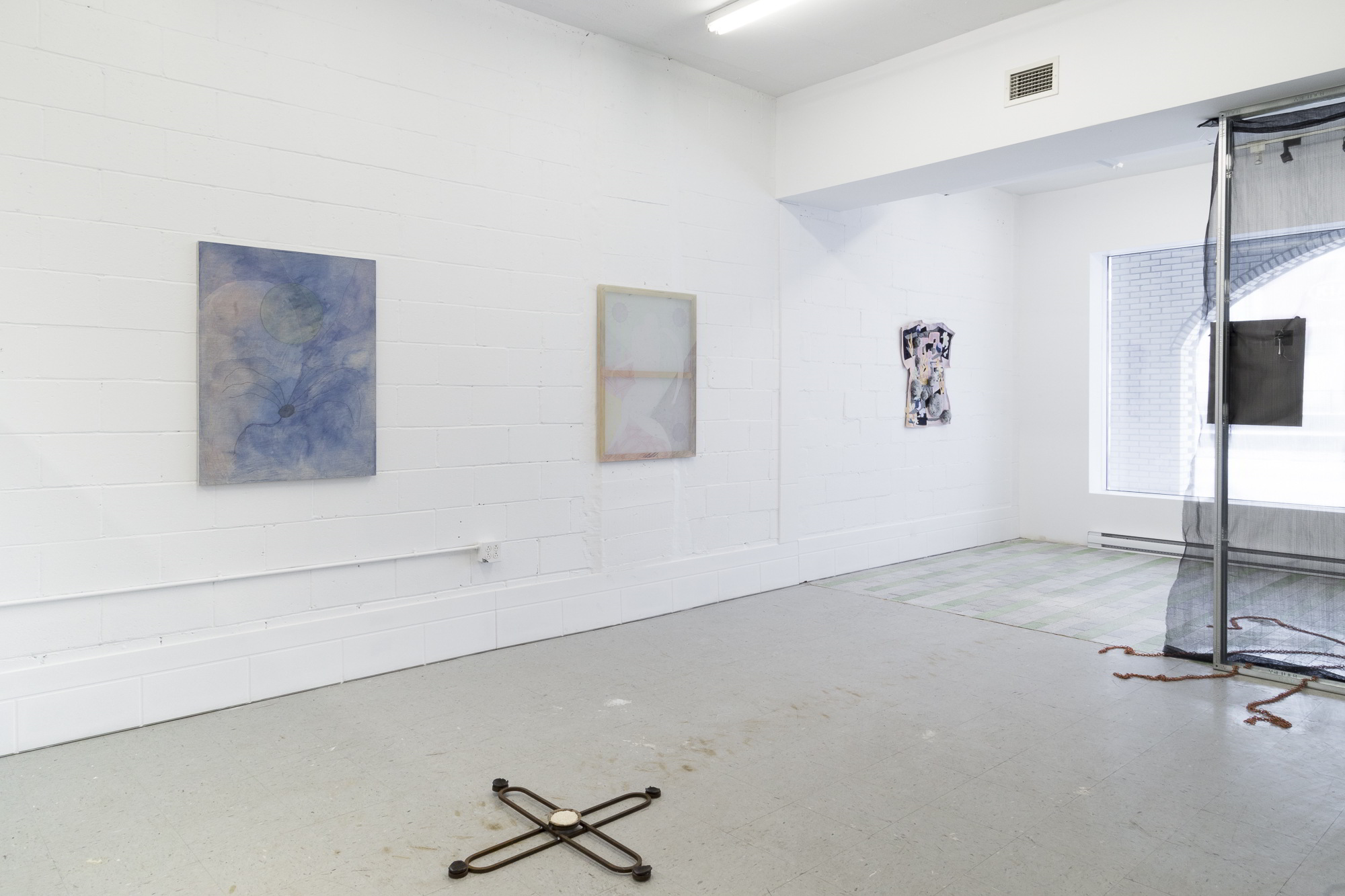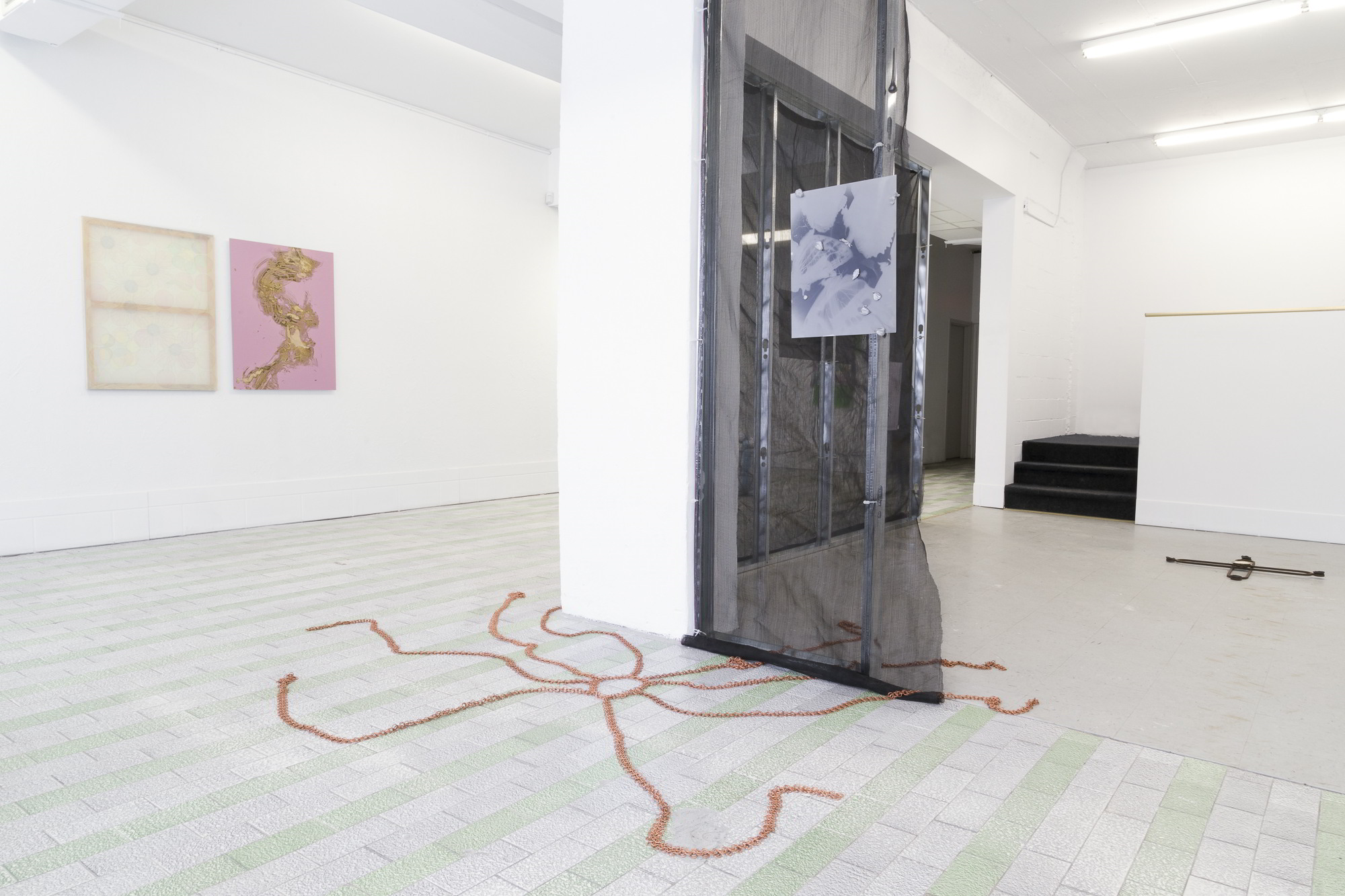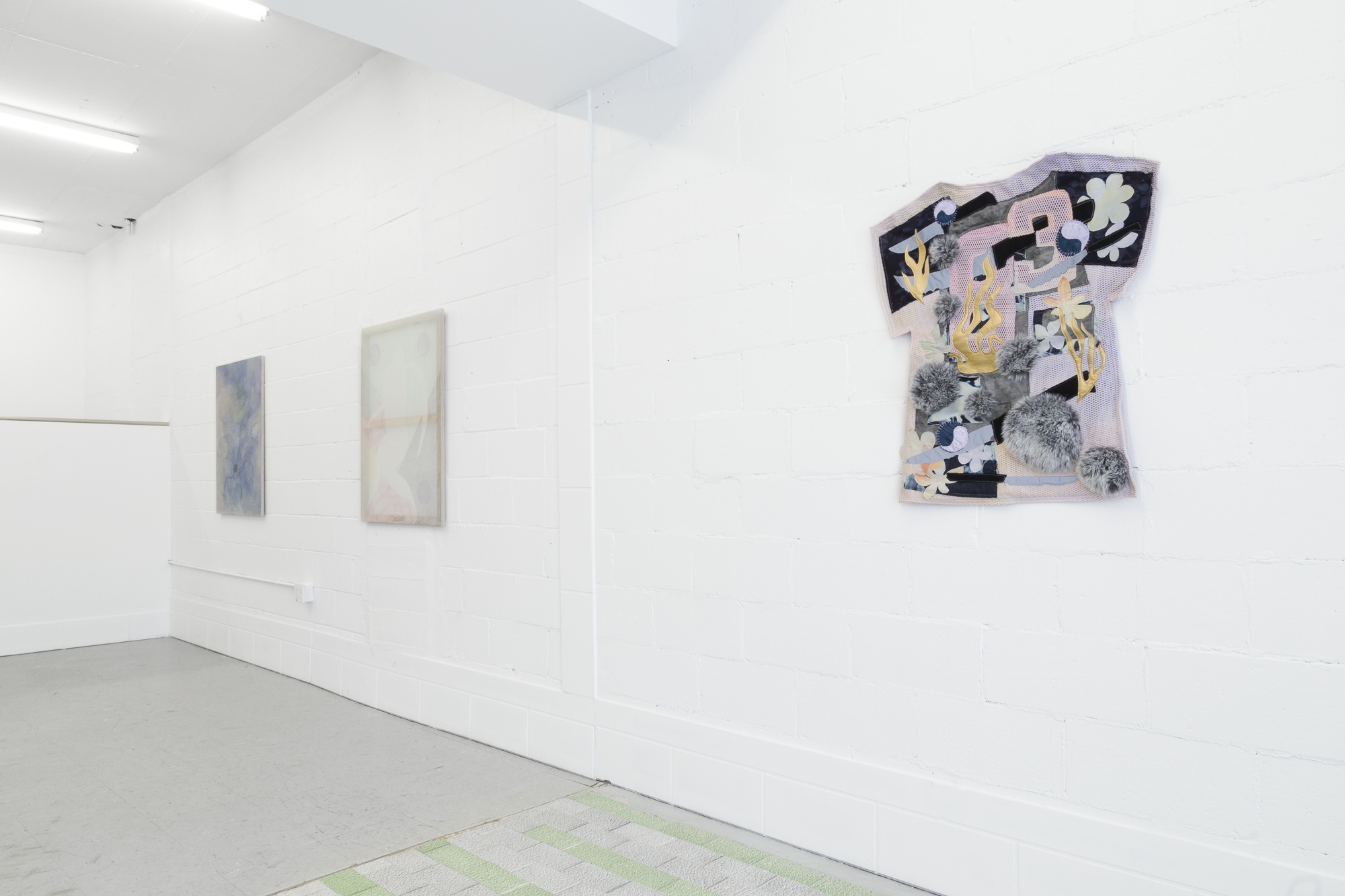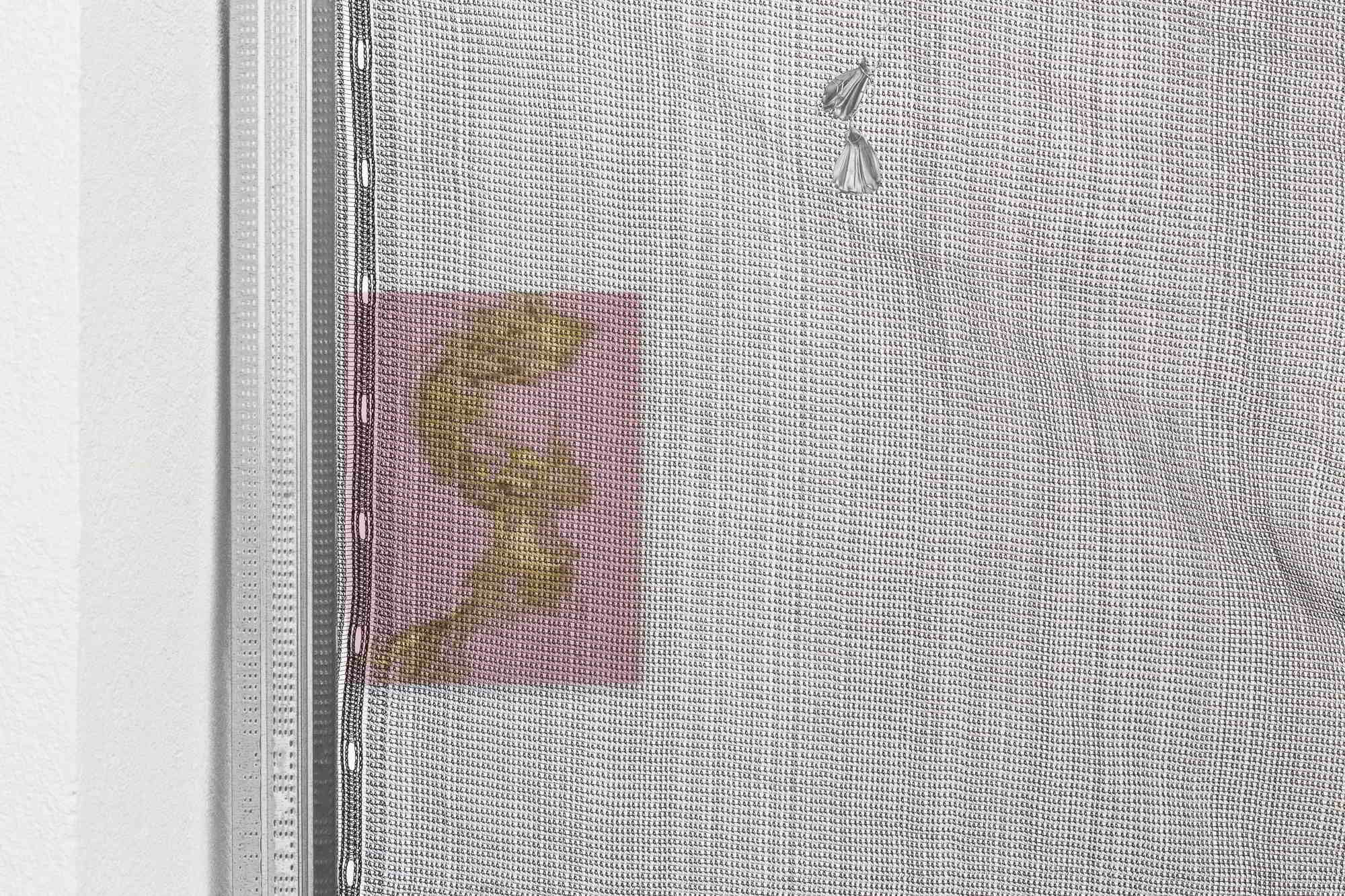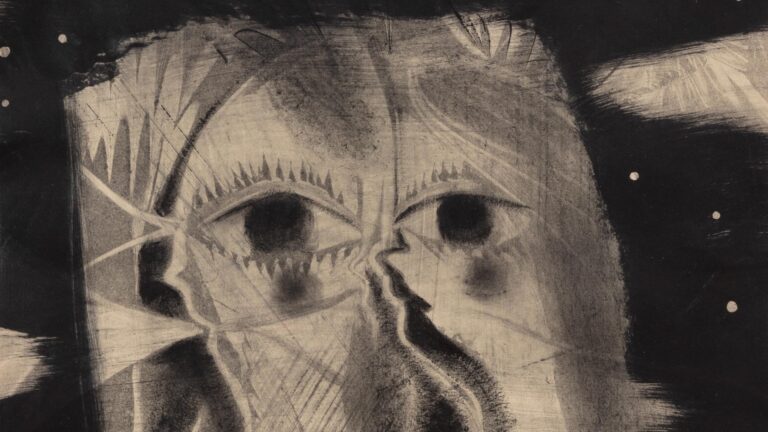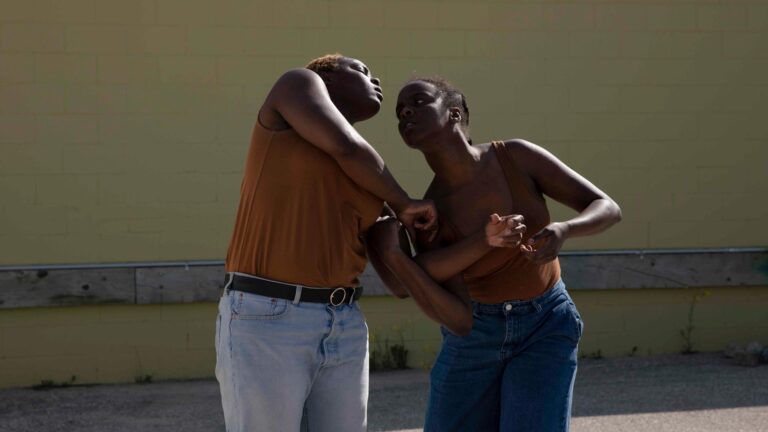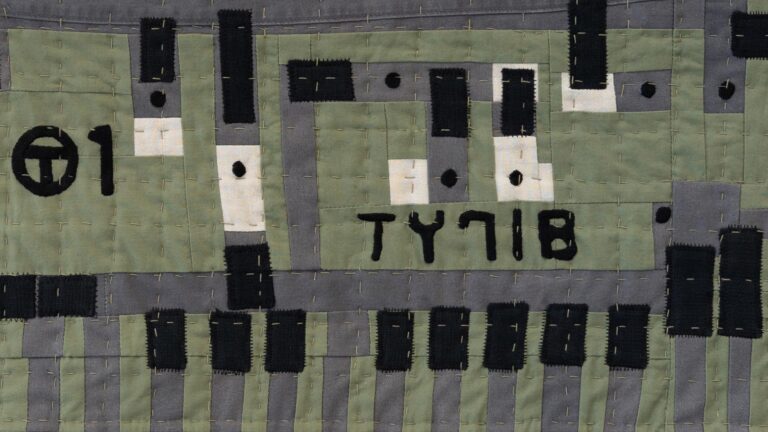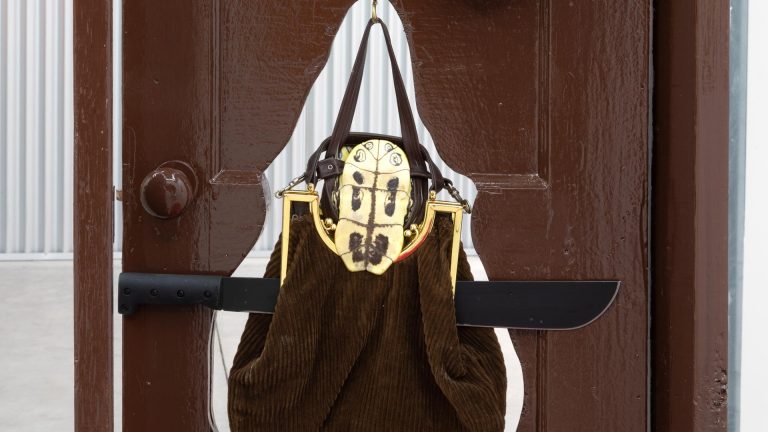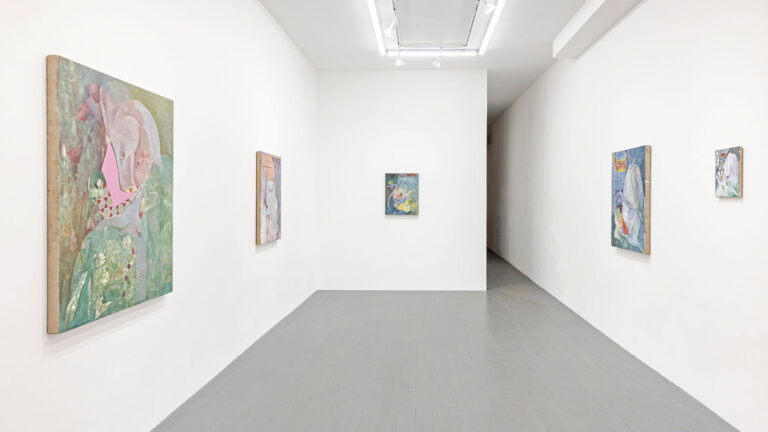Artists: Hanna Hur, Laurie Kang, Maia Ruth Lee, Zadie Xa
Exhibition title: Four Pillars
Venue: L’INCONNUE, Montreal, Canada
Date: February 3 – May 26, 2018
Photography: all images copyright and courtesy of the artists and L’INCONNUE, Montreal
In alchemy, the moon is symbolized by a crescent, drawn sometimes as a scythe but just as often in the orientation of a vessel. Whatever the form, its symbol points to the moon’s essential quality as neither weapon nor womb but continuous change. Four Pillars presents work engaged in moments of metamorphosis. For the works on view, stillness is illusory, from Maia Ruth Lee’s scrap iron altars, whose ceremonial rice absorbs and transforms the energy of its surroundings, to Hanna Hur’s nearly translucent drawings on silk, which surrender their visual clarity to the changing conditions of its installation. In Laurie Kang’s Soup, an impression of lotus roots on unfixed photochemical paper migrates to Roots, where the lotus re-appears in charcoal as a material negative and above which a single stem of incense slowly dissipates. Roots take on a different referent in Zadie Xa’s propositions, where symbols of her personal and collective history are utilized to charge the clothing of an imagined shamanistic avatar. A provisory wall by Kang bisecting a portion of the exhibition acts as a nucleus around which the show orients.
“Many stories of the wall have been told,” writes Trinh T. Minh-ha. We know these stories. Divisions “between West and the Rest, …materiality and spirituality, masculine and feminine, or more intimately, between outside and inside, self and other.” Boundaries of distinction built upon a language of difference. But Kang’s structure disturbs the language of the wall. Rendered as open netting on construction scaffolding, the boundary doesn’t just divide one space from another—it is a haptic surface, a skin as screen, a porous woven membrane stretched taut against a skeleton of steel in imprecise, undulating tension. The wall is its own body, or bodies, intertwined. In Skin on Skin, Kang captures the boundary as an electric moment between two bodies whose meeting indelibly alters the other. Unfixed and unprocessed, the image holds on to its touch, even as its surface continues to evolve with the conditions of its environment. Framed within the structure of the wall, we confront the nature of these charged exchanges, between outside and inside, self and other. With its layer of woven netting, the scaffold also begins to entangle the works on view around it, ensnaring Hur’s delicately rendered drawings and Xa’s speculative fantasies in a web of relation. Hur’s Mother ii, a copper chainmail spider, sprawls nearby as a kind of diaphanous armor, suggesting alternative terms of empowerment that derive strength from fluid morphology rather than hard monumentality. Copper is associated with the planet Venus, and its appearance in the form of a predator nods to Louise Bourgeoise as well as the history of women whose sexuality has been both revered and reviled.
Like the structure that supports it, Kang’s photosensitive pictures continually shift between surface and skin, image and embodiment, to claim an in-between space of resistance that escapes naming and lays the conditions to reclaim ontological agency. In She Unnames Them, Ursula K. Le Guin describes unnaming as a form of empowerment. “Their names had stood between myself and them like a clear barrier,” she writes, “…And the attraction that many of us felt, the desire to smell one another’s smells, feel or rub or caress one another’s scales or skin or feathers or fur…—that attraction was now all one with the fear, and the hunter could not be told from the hunted, nor the eater from the food.”
Unnamed, Xa’s speculative avatar reclaims its shamanistic power to shapeshift. Clothed in a field of symbols gathered from her own past and Korean mythology, the referents in Xa’s work are summoned in order to interrogate and to be interrogated. But Xa’s avatar isn’t just a shapeshifting shaman, and neither is the in-between in which she operates an escapist fantasy. Xa’s avatar is a woman who code-switches at the fraught sociopolitical boundaries between self and other. Unnamed, she occupies a third space from which the in-between casts a numinous shadow on the wall separating our experience of reality and the possibilities that lay beyond material understanding. “The direction of escape is toward freedom,” writes Ursula K. Le Guin, “So what is ‘escapism’ an accusation of?”
In the numinous world of the in-between, Hur’s unnamed figure in Endless Spring vii resurrects under three black suns. Endless Spring vii constitutes the seventh iteration of a painting from Hur’s archive which reinvents itself each time it is reproduced. Here, its remaking as a drawing on silk proposes an image whose meaning lays less in visual clarity than in its dissipation. Silk serves as a surface on which the drawing can appear in order to disappear—a veil beyond which we are meant to peer. And while Endless Spring vii shows a figure suspended in the process of dissolution, it also carries with it the history of each embodiment that came before.
Many of the works in Four Pillars carry traces of its making and the artist’s personal history. In Soup, Kang’s photograms are marked by the residue of its process as part of the pictorial surface. Leftover silicone, wire, and cast aluminum gather with bits of bronze on photosensitive paper alongside fingerprints from a messy studio process that encourages material infections. In Mother’s Knot, Lee arranges banana leaf bowls from Nepal with welded scrap metal scavenged from Gowanus, a notorious industrial neighborhood in Brooklyn. The materials are anchored with bowls of ceremonial rice, thought to purify energy and invite abundance in Nepalese tradition. Mother’s Knot is a site of transformation, elevating industrial detritus with the rarified aura of an art object, and imbuing it with ritualistic significance. But it also functions as a personal altar, where Lee releases her own experiences of adversity to the rice’s magical absorbency. In Mother’s Knot, as with many of the works on view, Four Pillars demonstrates a sense of hopefulness in the potency of transformative power, and gestures to the possibility of manifesting the numinous other world in our tangible experience.
-Sarah Chow
Four Pillars, 2018, exhibition view, L’INCONNUE, Montreal
Four Pillars, 2018, exhibition view, L’INCONNUE, Montreal
Four Pillars, 2018, exhibition view, L’INCONNUE, Montreal
Maia Ruth Lee, Of Woman Born, 2018, Steel, Paper clay, White Basmati Rice, 48.5” x 20.5” x 2”
Maia Ruth Lee, Mother’s Knot, 2018, Steel, Paper clay, White Basmati Rice, 30.5” x 30.5” x 2”
Maia Ruth Lee, Bondage Baggage Prototype I and II, 2017, Tarp, Rope, Tape, Cotton filling, 23”L x 13”H x 11”W, 22”L x 23”H x 16”W
Hanna Hur, Nervy, 2017, coloured pencil on Silk, 40” x 30”
Laurie Kang, Skin on Skin, 2016, Unfixed, unprocessed photographic paper and darkroom chemicals (continually sensitive) mounted to dibond, 30” x 40”
Hanna Hur, Fever II, 2017, watercolor, china marker and color pencil on linen, 30 x 40 inches
Hanna Hur, Endless Spring vii, 2017, coloured pencil on Silk, 30” x 40”
Four Pillars, 2018, exhibition view, L’INCONNUE, Montreal
Four Pillars, 2018, exhibition view, L’INCONNUE, Montreal
Four Pillars, 2018, exhibition view, L’INCONNUE, Montreal
Four Pillars, 2018, exhibition view, L’INCONNUE, Montreal
Four Pillars, 2018, exhibition view, L’INCONNUE, Montreal
Four Pillars, 2018, exhibition view, L’INCONNUE, Montreal
Four Pillars, 2018, exhibition view, L’INCONNUE, Montreal
Four Pillars, 2018, exhibition view, L’INCONNUE, Montreal
Four Pillars, 2018, exhibition view, L’INCONNUE, Montreal
Maia Ruth Lee, Acqua Alta, 2018, Steel, 33.5” x 5” x 2”
Laurie Kang, Knotting, 2017, Darkroom prints, cast aluminum, cast bronze, 16” x 40”
Laurie Kang, Knotting, 2017, Darkroom prints, cast aluminum, cast bronze, 16” x 40”
Four Pillars, 2018, exhibition view, L’INCONNUE, Montreal
Hanna Hur, Mother II, 2017, hand-shaped, cut, and linked copper, dimensions variable
Laurie Kang, Soup I, 2017, Photogram, darkroom print, cast aluminum, mounted to dibond, 20” x 32”
Laurie Kang, Soup II, 2017, Photogram, darkroom print, silicone, wire, cast bronze, 20”x 32”
Four Pillars, 2018, exhibition view, L’INCONNUE, Montreal
Four Pillars, 2018, exhibition view, L’INCONNUE, Montreal
Four Pillars, 2018, exhibition view, L’INCONNUE, Montreal
Four Pillars, 2018, exhibition view, L’INCONNUE, Montreal
Four Pillars, 2018, exhibition view, L’INCONNUE, Montreal
Four Pillars, 2018, exhibition view, L’INCONNUE, Montreal
Four Pillars, 2018, exhibition view, L’INCONNUE, Montreal
Four Pillars, 2018, exhibition view, L’INCONNUE, Montreal
Four Pillars, 2018, exhibition view, L’INCONNUE, Montreal
Four Pillars, 2018, exhibition view, L’INCONNUE, Montreal
Four Pillars, 2018, exhibition view, L’INCONNUE, Montreal
Four Pillars, 2018, exhibition view, L’INCONNUE, Montreal
Four Pillars, 2018, exhibition view, L’INCONNUE, Montreal
Four Pillars, 2018, exhibition view, L’INCONNUE, Montreal
Laurie Kang, Root, 2017, Polymer clay, incense, 13” x 7” approx
Four Pillars, 2018, exhibition view, L’INCONNUE, Montreal
Four Pillars, 2018, exhibition view, L’INCONNUE, Montreal
Four Pillars, 2018, exhibition view, L’INCONNUE, Montreal
Four Pillars, 2018, exhibition view, L’INCONNUE, Montreal
Four Pillars, 2018, exhibition view, L’INCONNUE, Montreal


